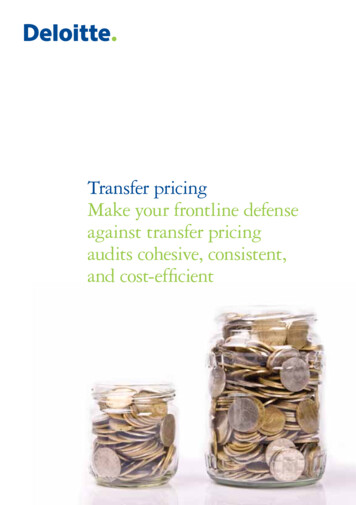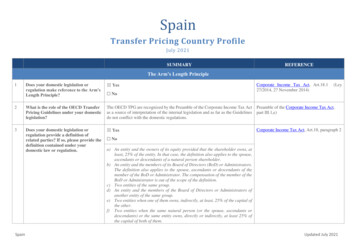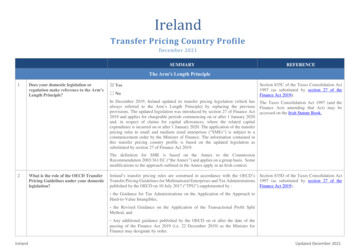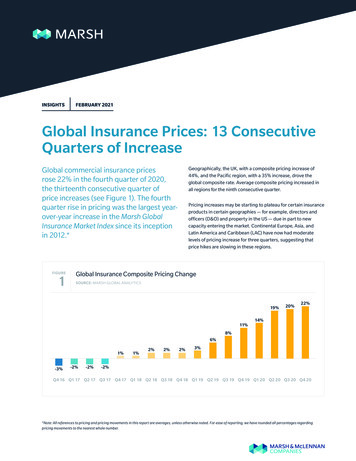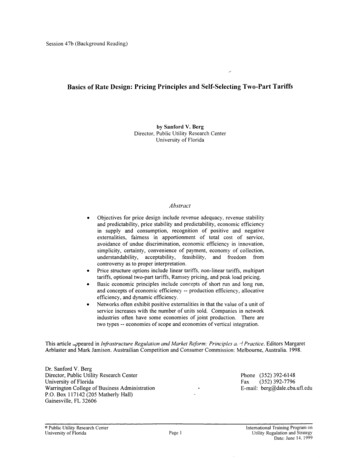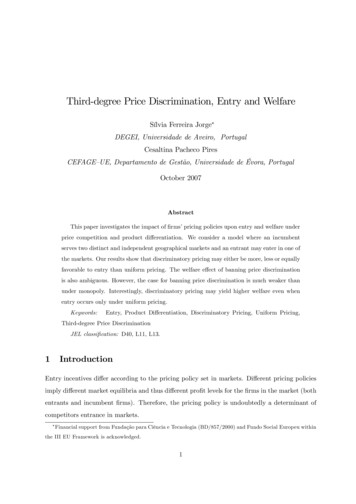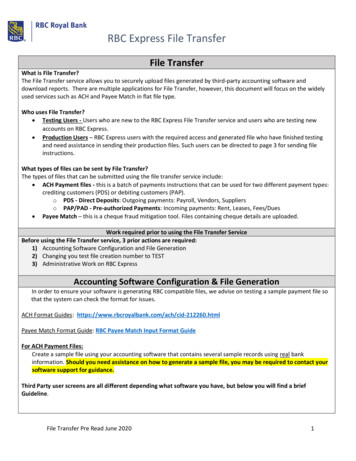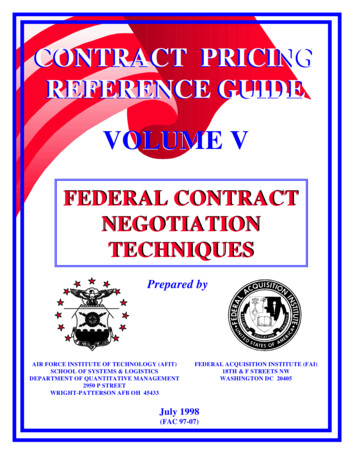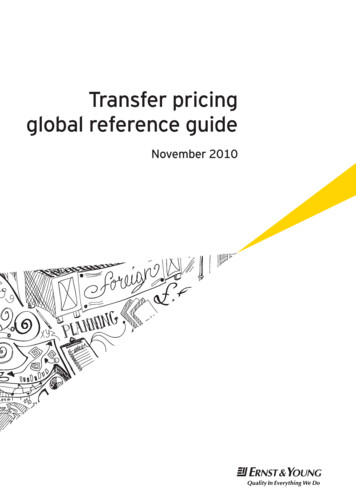
Transcription
Transfer pricingglobal reference guideNovember 2010
Transfer pricingglobal reference guidePlanning transfer pricing strategies, working to limit tax exposure anddefending a company’s return position and transfer pricing practices ona global basis require knowledge of a complex web of country tax laws,regulations, rulings, methods and requirements.The Ernst & Young Transfer pricing global reference guide is a tooldesigned to enable international tax executives to quickly identify thetransfer pricing rules, practices and approaches that have been adopted bymore than 50 countries and territories. These various approaches must beunderstood in order to complete both compliance and planning activities.The guide outlines basic information for the covered jurisdictions regardingtheir transfer pricing tax laws, regulations and rulings, Organisation forEconomic Co-operation and Development (OECD) guidelines treatment,priorities and pricing methods, penalties, the potential for relief frompenalties, documentation requirements and deadlines, statute oflimitations, required disclosures, audit risk and opportunities for advancepricing agreements (APAs).A web-based version of this brochure can be found at www.ey.com/transferpricingguide. Please check this web page periodically for latebreaking country developments. Commentaries from transfer pricingprofessionals are also available at this site. gj Y egj] \]lYad]\ \ak[mkkagf g Yfq g l ] [gmfljq%kh][aÕ[ ljYfk ]j pricing rules, or to obtain further assistance in addressing and resolvingintercompany transfer pricing issues, please contact your local jfkl Qgmf g Õ[] l ] j]d]nYfl [gmfljq [gflY[l dakl]\ Yl l ] ZY[c g l ak brochure or send us a query at www.ey.com/transferpricingguide.Please note the availability of other transfer pricing materials such assurvey reports that share views of tax authorities and tax directors(www.ey.com/tp). Ernst & Young also annually produces The WorldwideCorporate Tax Guide, The Global Executive and the Worldwide VAT, GSTand Sales Tax Guide.Transfer pricing global reference guide2Contents
ContentsLegend5Lithuania92Glossary of 1MexicoAustria14Netherlands102Belgium16New oatia34Portugal121Czech gapore128Egypt44Slovak Republic131Estonia47Slovenia134Finland49South Africa137France51South 154Ireland73Turkey157Israel75United Kingdom160Italy78United Kenya87Vietnam170Latvia90Transfer pricing contacts173Transfer pricing global reference guide3Contents
Transfer pricing global reference guide4Contents
LegendAll rules are current as of November 2010.Taxing authority and tax law: Name of taxing authority and statutory provisions currently in effect in eachcountry.Relevant regulations and rulings: Current transfer pricing rules and regulatory provisions in effect in eachcountry.OECD guidelines treatment: Consideration given by the taxing authority to the OECD Transfer Pricing Guidelines.Priorities/pricing methods: Transfer pricing methods allowed, as well as the priority of each method.Transfer pricing penalties: Discussion of potentially applicable transfer pricing penalties if a taxpayer isdetermined not to be in compliance with the rules imposed by the taxing authority.Penalty relief: Potential ways in which penalties may be reduced or avoided.Documentation requirements: Governing tax authority requirements or recommendations that taxpayers prepareYf\ eYaflYaf ojall]f \g[me]flYlagf lg [gfÕje l Yl l ] Yegmflk [ Yj ]\ af j]dYl]\%hYjlq ljYfkY[lagfk Yj] consistent with the arm’s-length standard.Documentation deadlines: Deadline for preparing transfer pricing documentation.Statute of limitations on transfer pricing assessments: Discussion of the applicable statute of limitationsregarding transfer pricing examination and assessments.Return disclosures/related-party disclosures: Information on disclosures required from taxpayers regardingrelated -party transactions.Audit risk/transfer pricing scrutiny: Discussion of the level of risk of the tax authority scrutinizingrelated-party transactions. This is based on the past experience of our local tax professionals and is not a forwardlooking prediction.APA opportunity: Discussion of the possibility of obtaining an advance pricing agreement with the tax authority.Transfer pricing global reference guide5Contents
Glossary of termsAPA (advance pricing agreement)An agreement between a tax authority and an MNE about thedetermination of the appropriate transfer pricing method tobe used for pricing intercompany transactions. APAs may beunilateral, bilateral (two governments) or multilateral (three or moregovernments).Arm’s-length principleThe standard adopted by the OECD that transactions betweene]eZ]jk g Yf EF k gmd\ j]Ö][l [gf\alagfk l Yl ogmd\ Z] eY\] between independent enterprises.CFC (controlled foreign corporation) A subsidiary and member ofan MNE group.CPE (comparable proÔts method)Mf\]j l ] [gehYjYZd] hjgÕlk e]l g\ g MK Lj]Ykmjq J] mdYlagfk Section 1.482-5, an arm’s-length result is determined by comparingl ] gh]jYlaf hjgÕl g l ] Él]kl]\Ê hYjlq oal l ] gh]jYlaf hjgÕl of an uncontrolled party involved in comparable transactions. Thus,l ] ;HE dggck Yl hjgÕlk jYl ]j l Yf ljYfkY[lagfk& ?]f]jYddq l ] l]kl]\ hYjlqÌk hjgÕl ak e]Ykmj]\ af l]jek g HDAk km[ Yk jYl] g j]lmjf gf [YhalYd ]ehdgq]\ gj l ] jYlag g jgkk hjgÕl lg gh]jYlaf expenses. The regulations state that the tested party shouldfgjeYddq Z] l ] Éd]Ykl [gehd]pÊ g l ] [gfljgdd]\ ]flala]k& Lj]Yk& Regs. §1.482-5(b)(2).CSA (cost-sharing arrangements)CUP (comparable uncontrolled price)A transfer pricing method that compares the price for propertyor services in a controlled transaction with the price charged forproperty or services transferred in a comparable uncontrolledtransaction in comparable circumstances.Transfer pricing global reference guide6Contents
OECD guidelinesTransfer Pricing Guidelines for Multinational Enterprises and TaxAdministrations, published by the OECD between 1995 and 1998.The OECD guidelines endorse the arm’s-length principle and consistg Y klYl]e]fl g hjaf[ahd]k jYl ]j l Yf Y k]l g kh][aÕ[ jmd]k lg Z] applied.ETR (effective tax rate)EU (European Union)The European Union, currently consisting of 27 member states.EUJTPF (EU Joint Transfer Pricing Forum)The EU Joint Transfer Pricing Forum consists of representativesof governments and the private sector who advise and consult ontransfer pricing issues.OECD Model Tax ConventionModel Tax Convention on Income and Capital, last published bythe OECD in July 2005. The Model Tax Convention is to be used bymember states in negotiations of bilateral double tax treaties. TheOECD also provides commentary on the interpretation of the ModelTax Convention and states that member countries should follow thiscommentary, subject to their expressed reservations thereon, whenapplying and interpreting their double tax treaties.FTE (full-time equivalent)Used in this survey to indicate the number of resources employedby tax authorities to undertake transfer pricing reviews in theirjurisdiction.GAAP (Generally Accepted Accounting Principles)MNE (multinational enterprise)A member of a related group that carries on business directly orindirectly in two or more countries.MoU (memorandum of understanding)PDA (proÔt level indicators)JYlagk l Yl e]Ykmj] l ] j]dYlagfk ah Z]lo]]f Yf ]flalqÌk hjgÕl Yf\ l ] j]kgmj[]k afn]kl]\ gj [gklk af[mjj]\ lg Y[ a]n] l Yl hjgÕl& J] ]j above to CPM for further discussion of their application.MAP (mutual agreement procedure)A dispute resolution process found in Article 25 of the OECD ModelTax Convention. MAP is a government-to-government process ofnegotiation to resolve matters of taxation not in accordance withthe particular tax treaty and to attempt to avoid double taxation.PATA (PaciÔc Association of Tax Administrators)An association of the tax administrations of Australia, Canada,Japan and the United States formed to foster cooperation andthe exchange of information among them. PATA has publishedguidance on APAs, MAPs and documentation requirements.OECD (Organisation for Economic Co-operation andDevelopment)An intergovernmental organization, based in Paris, formed to fosterinternational trade and economic development. The OECD has 30member states. Among its many concerns are the removal of taxZYjja]jk lg l ] j]] Ögo g gg\k Yf\ k]jna[]k Yf\ l ] Ynga\Yf[] g \gmZd] lYpYlagf g af[ge] gj hjgÕlk& L ] G ; Yk \]n]dgh]\ guidelines and a model tax convention; see below.Transfer pricing global reference guideICSA (qualiÔed cost sharing arrangements)TNMM (transactional net margin method)L ] ljYfkY[lagfYd f]l eYj af e]l g\ ak Y hjgÕlk%ZYk]\ e]l g\ l Yl [gehYj]k l ] hjgÕlYZadalq g Yf EF e]eZ]j oal l ] hjgÕlk g comparable entities undertaking similar transactions. The CPM inthe United States is similar to TNMM.7Contents
ArgentinaTaxing authority and tax lawTax authority: Internal Revenue Service (Administración Federal de Ingresos Públicos, or AFIP))Tax law: Income Tax Law (ITL) and RegulationsRelevant regulations and rulingsRegulations currently in effect: 9 AH% ?A 9 AH% aj][[a f ?]f]jYd AehgkalanY! J] mdYlagf Fg& ) )** HmZdak ]\ ) G[lgZ]j *(() Zml Yhhda[YZd] gj Õk[Yd q]Yjk beginning on 31 December 1999) as amended by several regulations (No. 1,227/02; No. 1,296/02; No. 1,339/02; No. 1,590/03; No.1,663/04; No. 1,670/04; No. 1,918/05; No. 1,958/05, No. 1,987/05 and External Note No. 1/08) Binding tax rulings for general application are not provided Opinions from the tax authority are scarce and non-bindingOECD guidelines treatmentArgentina is not an OECD member, and the OECD Transfer Pricing guidelines are not referenced in Argentina’s Tax Law and Regulations.However, the tax authority usually recognizes the OECD Transfer Pricing guidelines in practice as long as they do not contradict the ITL andRegulations.9 Õjkl%d]n]d [gmjl [Yk] \Yl]\ )- 9m mkl *((/ oYk ZYk]\ gf l ] hjgnakagfk g l ] G ; LjYfk ]j Hja[af ma\]daf]k& Gl ]j egj] j][]fl Õjkl%level court cases also recognized the use of the OECD Transfer Pricing guidelines as long as they do not contradict the ITL and Regulations.Priorities/pricing methodsThe tested party must be the local entity (i.e., the entity based in Argentina). The taxpayer selects the most appropriate method, but theAFIP may oppose the selection. The accepted methods for transactions with related parties and tax havens pursuant to the ITL are the[gehYjYZd] mf[gfljgdd]\ hja[] ;MH! j]kYd] hja[] [gkl hdmk hjgÕl khdal Yf\ ljYfkY[lagfYd f]l eYj af e]l g\k& L ] ALD \g]k fgl hjagjalar] methods. Regulation 1,122/01 states the best method rule.The use of an interquartile range is mandatory. Unless there is evidence to the contrary, the market price must be used for tangible goodstransactions with both related and independent parties where there is an international price in a transparent market.For transactions involving grains, oleaginous products, other soil products, oil and gas and in general all goods with well-known prices inljYfkhYj]fl eYjc]lk Yf\ o ]j] l ] dg[Yd [gehYfq gh]jYl]k l jgm afl]jfYlagfYd afl]je]\aYja]k l Yl Yj] fgl l ] ÕfYd [gfka f]]k g l ] gg\k l ] Yhhda[YZd] hja[] ak l ] hj]nYadaf hja[] af l ] j]kh][lan] eYjc]l gf l ] \Yq dgY\af gj k ahe]fl ak Õfak ]\ gj l ] Y j]]\%mhgf price if higher. This method may not apply, however, if the local exporter is able to prove the substance of the operations of the consigneeabroad. The AFIP has the power to limit the application of this method or extend it to other transactions under certain circumstances.Export and import transactions with independent parties not located in tax havens are subject to information requirements if the annualamount of the transaction exceeds ARS1m or the transactions are exports and imports of commodities. The requirements depend on\a ]j]fl YffmYd ljYfkY[lagf Yegmflk Yf\ af kge] [Yk]k eYq af[dm\] [Yd[mdYlagfk g hjgÕl eYj afk&Transfer pricing global reference guide8Contents
Argentina (continued)Transfer pricing penalties gj mfhYa\ lYp]k j]dYl]\ lg afl]jfYlagfYd ljYfkY[lagfk l ] lYphYq]j ak Õf]\ )(( lg ,(( g l ] mfhYa\ lYp& L ak Õf] ak jY\mYl]\ depending upon the level of compliance with the formal duties related to the control of the taxes derived from international transactionsestablished by the AFIP. Penalties for fraud are 2 to 10 times the unpaid taxes.;jaeafYd lYp dYo klahmdYl]k aehjakgfe]fl gj log lg kap q]Yjk a l ] mfhYa\ lYp ]p[]]\k 9JK)(( ((( gj ]Y[ lYp Yf\ Õk[Yd q]Yj& A l ] mfhYa\ lYp ]p[]]\k 9JK)e l ] hjakgf l]je oadd af[j]Yk] jYf af jge l j]]%Yf\%Y% Yd lg faf] q]Yjk& gj l ] dYl] Õdaf g lYp j]lmjfk [gflYafaf afl]jfYlagfYd ljYfkY[lagfk afngdnaf l ] ]phgjl'aehgjl g gg\k oal af\]h]f\]fl hYjla]k l ] lYphYq]j oadd Z] Õf]\ 9JK1 (((& gj l ] dYl] Õdaf g lYp j]lmjfk [gf[]jfaf gl ]j afl]jfYlagfYd ljYfkY[lagfk l ] lYphYq]j oadd Z] Õf]\ 9JK*( (((& gj l ] Yhhda[Ylagf g h]fYdla]k j]dYl]\ lg dYl] Õdaf gj dY[c g Õdaf al ak ajj]d]nYfl o ]l ]j l ] ljYfkY[lagfk o]j] Yl YjeÌk d]f l & gj fgf%[gehdaYf[] oal l ] gjeYd \mla]k g mjfak af af gjeYlagf j]im]kl]\ Zq l ] 9 AH l ] lYphYq]j Y[]k Õf]k mh lg 9JK,- (((& L ] kYe] Yhhda]k lg Y Yadmj] lg c]]h ngm[ ]jk Yf\ ]na\]f[] g hja[]k gf YnYadYZd] Õd]k Yf\ Yadmj] lg Õd] lYp j]lmjfk mhgf j]im]kl& A lYp j]lmjfk Yj] fgl Õd]\ Y l]j l ] l aj\ j]im]kl Yf\ l ] lYphYq]j Yk af[ge] Yegmflaf lg egj] l Yf 9JK)(e l ] Õf] ak af[j]Yk]\ jge 9JK1( ((( lg 9JK,-( (((& Afl]j]kl ak Yhhda[YZd] gf mfhYa\ lYp ZYdYf[]k jge ) Bmdq *((. l ] jYl] ak * gf Y egfl dq ZYkak Yf\ mhgf Õdaf g Y dYokmal!&Penalty reliefConcerning underpayment and fraud, if the non-recidivist taxpayer voluntarily amends the tax returns before receiving a special noticegj naklY! jge l ] 9 AH l ] h]fYdlq ak j]\m[]\ lg gf]%l aj\ g l ] eafaeme Õf]& A l ] lYp j]lmjfk Yj] Ye]f\]\ oal af )- \Yqk g j][]ahl g l ] fgla[] l ] h]fYdlq ak j]\m[]\ lg log%l aj\k g l ] eafaeme Õf]& A l ] fgf%j][a\anakl lYphYq]j Y[[]hlk l ] Y\bmkle]flk Ykk]kk]\ by AFIP and pays the amounts due, the penalties are set at the minimum amount. If the taxes due do not exceed ARS1,000 and are paidvoluntarily, or within 15 days of the special notice, then no penalty shall be applied.Documentation requirementsTransfer pricing regulations require extensive contemporaneous documentation. Taxpayers are required to keep and eventually submit alll ] \g[me]flk ]na\]f[af l Yl hja[]k Yegmflk j][]an]\ Yf\ hjgÕl eYj afk Yn] Z]]f ]klYZdak ]\ gf Yf YjeÌk%d]f l ZYkak& mjl ]jegj] lYphYq]jk Yj] j]imaj]\ lg Õd] Yf YffmYd ljYfk ]j hja[af klm\q gj ljYfkY[lagfk kmZb][l lg ljYfk ]j hja[af e]l g\k oal j]dYl]\ hYjla]k deemed related parties and independent parties located in tax havens.Documentation deadlinesL ] ljYfk ]j hja[af \g[me]flYlagf emkl Z] j]Y\q gj Õdaf oal l ] 9 AH Zq l ] \Yl] l ] [gjj]khgf\af ljYfk ]j hja[af j]lmjf Õdaf k Yj] \m]& 9f YffmYd ljYfk ]j hja[af klm\q ÕfYf[aYd klYl]e]flk Yf\ []jlaÕ[Ylagf emkl Z] Õd]\ oal l ] lYp Yml gjalq Zq l ] ]f\ g l ] ]a l egfl Y l]j l ] ]f\ g l ] Õk[Yd q]Yj&L ] YffmYd ljYfk ]j hja[af j]lmjf emkl Ydkg Z] Õd]\ Zq l ] ]f\ g l ] ]a l egfl Y l]j l ] ]f\ g l ] Õk[Yd q]Yj& @go]n]j l ] ljYfk ]j hja[af Y\bmkle]flk emkl Z] j][g far]\ o ]f l ] af[ge] lYp j]lmjf ak \m] a&]& Õ l egfl Y l]j l ] Õk[Yd q]Yj%]f\!& L ] k]eaYffmYd j]lmjfk emkl Z] Õd]\ Zq l ] ]f\ g l ] Õ l egfl Y l]j l ] ]f\ g l ] j]d]nYfl kap%egfl h]jag\& L ] YffmYd j]lmjf gj ]phgjl Yf\ aehgjl ljYfkY[lagfk oal af\]h]f\]fl hYjla]k fgl dg[Yl]\ af lYp Yn]fk emkl Z] Õd]\ Zq l ] ]f\ g l ] k]n]fl egfl Y l]j l ] ]f\ g l ] Õk[Yd year.Statute of limitations on transfer pricing assessmentsThe general statute of limitations for federal tax matters is 5 years for registered taxpayers or those exempt from registration and 10 yearsfor unregistered taxpayers. These periods begin on 1 January of the year following the year in which the tax return is due. The moratoriumj] ae] af hdY[] \mjaf [Yd]f\Yj q]Yj *((1 Y\\]\ gf] q]Yj lg l ] klYlml] g daealYlagfk h]jag\ gj []jlYaf Õk[Yd q]Yjk& L ] ljYfk ]j hja[af \g[me]flYlagf emkl Z] c]hl Zq l ] lYphYq]j Yf\ hjgna\]\ mhgf 9 AH k j]im]kl gj mh lg Õn] q]Yjk Y l]j l ] h]jag\ ]klYZdak ]\ Zq l ] statute of limitations.Transfer pricing global reference guide9Contents
Argentina (continued)Return disclosures/related-party disclosuresLYphYq]jk Yj] j]imaj]\ lg Õd] l ] gddgoaf \g[me]flYlagf oal l ] 9 AH2 An annual transfer pricing study 9m\al]\ ÕfYf[aYd klYl]e]flk gj l ] Õk[Yd q]Yj 9f af\]h]f\]fl ;]jlaÕ]\ HmZda[ 9[[gmflYflÌk []jlaÕ[Ylagf g []jlYaf [gfl]flk g l ] ljYfk ]j hja[af klm\q Annual Form 743 return gje /,* j]lmjf gj l ] Õjkl kap%egfl h]jag\ g ]Y[ Õk[Yd q]Yj! Semi-Annual Form 741 return for commodities exports and imports with independent parties not located in tax havens Annual Form 867 return for other exports and imports with independent parties not located in tax havensAudit risk/transfer pricing scrutinyLjYfk ]j hja[af Ym\alk Yj] Z][geaf egj] j]im]fl Yf\ afl]fkan] kg l Yl Y a jakc eYq Z] Ykkme]\& Af Y\\alagf l ] Õjkl%d]n]d [gmjl cases are being published. Although the taxpayer position prevailed in most of these cases, the most recent decision was in favor of the taxauthority. It is likely that the tax authority will try to increase revenue and strictly enforce penalties with companies that are not complyingwith transfer pricing requirements.APA opportunity9H9k Yj] fgl kh][aÕ[Yddq Y\\j]kk]\&Transfer pricing global reference guide10Contents
AustraliaTaxing authority and tax lawLYp Yml gjalq2 9mkljYdaYf LYpYlagf G Õ[] 9LG!Tax law: Division 13 of Part III of Income Tax Assessment Act and relevant provisions of double tax treatiesRelevant regulations and rulingsTaxation Ruling (TR) TR92/11: Loans, TR94/14: Application of Division 13, TR95/23: APAs, TR97/20: Methodologies, TR98/11:Documentation, TR98/16: Penalties, TR 1999/1: Services, TR2000/16: Relief from Double Taxation, TR2001/11: PermanentEstablishments, TR2001/13: Interpretation of Australia’s Double Tax Agreements, TR2002/2: Meaning of Arm’s Length for the purposesg ,/9 /! ana\]f\ ]]eaf Hjgnakagfk LJ*((*'-2 ]Õfalagf g H]jeYf]fl klYZdak e]fl LJ*(( ')2 9jeÌk D]f l ]Zl L]kl LJ 2004/1: Cost Contribution Arrangements, TR2005/11: Branch Funding for Multinational Banks, TR2007/1: Consequential Adjustmentsand TR2010/7: Interaction of Transfer Pricing and Thin Capitalization Provisions. TR2010/D2: Transfer Pricing Implications of BusinessRestructures (issued in draft).Tax Determinations (TD) TD2002/20: Film Production Companies and the Impact of the Tax Offset Scheme, TD2202/28: Foreign BankElection to not Apply Part IIIB of the Income Tax Assessment Act (1936), TD2007/1: Market Value of Goodwill of an Entity that becomesa Member of a Consolidated Group. Draft Tax Determinations, TD2007/D20: Interaction of Division 13 and the Thin Capitalization Rules,TD2008/20: Interaction of Division 13 and the Debt/Equity Rules.ATO Booklets: Concepts and Risk Assessment, Applying the Arm’s Length Principle, Advance pricing arrangements, Documentationand Risk Assessment for Small to Medium Businesses, Dependent Agent Permanent Establishments, Marketing Intangibles, BusinessJ]kljm[lmjaf È ak[mkkagf HYh]j gf Yhhda[Ylagf g 9mkljYdaYÌk ljYfk ]j hja[af jmd]k Yf\ 9LG ak[mkkagf HYh]j gf AfljY% jgmh ÕfYf[] guarantees and loans — Application of Australia’s transfer pricing and thin capitalization rules.OECD guidelines treatmentThe ATO accepts the principles of the OECD guidelines and indicates in the relevant ATO transfer pricing tax rulings where there areÉ\a ]j]f[]k af ]eh Ykak gj ]pl]fkagfk g G ; hjaf[ahd]k&Ê L ] 9LG oadd [gfka\]j l ] mk] g Ydd g l ] G ; %j][g far]\ ljYfk ]j hja[af methods and will also consider broader (or other) methods for particular facts and circumstances.Priorities/pricing methodsL ] 9LG k]]ck lg Y\ghl l ] Éegkl YhhjghjaYl]Ê e]l g\& E]l g\k gmldaf]\ af 9LG jmdaf k af[dm\] ljY\alagfYd ljYfkY[lagf e]l g\k ;MH j]kYd] hja[] Yf\ [gkl hdmk! Yf\ hjgÕl e]l g\k hjgÕl khdal Yf\ LFEE!& 9dl gm ljY\alagfYd ljYfkY[lagf e]l g\k ]& & ;MH! eYq Z] preferred by the ATO, the TNMM is accepted as an appropriate method in circumstances where traditional transaction data is not available,comparable or reliable. Two recent transfer pricing decisions have placed more emphasis on transaction methods and have been critical ofthe particular applications of the TNMM.Transfer pricing penaltiesIf the Commissioner applies Division 13 and the relevant section of the International Tax Agreement Act, and it is determined thatl ]j] ak Y ljYfk ]j hja[af Y\bmkle]fl j]kmdlaf af Y lYp k gjl Ydd Y h]fYdlq g *- Yhhda]k Zml ak j]\m[]\ lg )( o ]j] l ] lYphYq]j [Yf demonstrate that it has a reasonably arguable position (RAP).O ]j] l ] lYp ;geeakkagf]j [Yf \]egfkljYl] l Yl l ] kgd] gj \geafYfl hmjhgk] ak lYp Ynga\Yf[] Y h]fYdlq jYl] g -( Yhhda]k Zml ak j]\m[]\ lg *- o ]j] l ] lYphYq]j [Yf \]egfkljYl] l Yl al Yk Y J9H& L ] lYphYq]j eYq Yn] Y J9H Éa al ogmd\ Z] [gf[dm\]\ af l ] circumstances, having regard to relevant authorities, that what is argued for is about as likely to be correct as incorrect or is more likely toZ] [gjj][l l Yf af[gjj][l&ÊH]fYdla]k [gmd\ af[j]Yk] Zq Y mjl ]j *( a l ] lYphYq]j Élggc kl]hk lg hj]n]fl gj gZkljm[lÊ l ] 9LG jge \ak[gn]jaf l ] lYp k gjl Ydd gj a a penalty was imposed for a previous accounting period.Transfer pricing global reference guide11Contents
Australia (continued)Transfer pricing penalties (continued)For 2004-05 and later income years, a Shortfall Interest Charge (SIC) will apply to any amount of tax shortfall from the day on whichaf[ge] lYp mf\]j l ] Õjkl Ykk]kke]fl gj l Yl af[ge] q]Yj oYk \m] Yf\ hYqYZd] lg l ] \Yq gf o a[ l ] ;geeakkagf]j Yn] fgla[] g Yf assessment. SIC applies regardless of whether the taxpayer is liable for any shortfall penalty.Penalty reliefH]fYdla]k oadd Z] j]\m[]\ Zq *( gj ngdmflYjq \ak[dgkmj] Y l]j fglaÕ[Ylagf g Yf Ym\al gj Zq 0( gj ngdmflYjq \ak[dgkmj] Z] gj] fglaÕ[Ylagf g Yf Ym\al& O ]j] l ] lYphYq]j Yk [gfl]ehgjYf]gmk \g[me]flYlagf a&]& hj]hYj]\ hjagj lg gj Yl l ] lae] g Õdaf l ] [gehYfqÌk YffmYd tax return and Schedule 25A) to support a RAP, the penalty may be reduced.The Commissioner of Taxation has discretionary power to remit penalties where he considers it fair and reasonable to do so. A taxpayerwith an APA will not incur penalties except in relation to non-arm’s-length dealings that are not covered by the APA or non-compliance withthe terms and conditions of the APA.Documentation requirementsThe ATO has outlined a four-step process in TR98/11 to assist companies in satisfying contemporaneous documentation requirements.This process is not mandatory but is highly recommended. The documentation should: Record the transfer price setting process and, in particular, verify the outcome of those transactions against the arm’s-length standard Include business, economic and industry analyses :] j]d]nYfl lg l ] 9mkljYdaYf gh]jYlagfk a&]& [gmfljq% Yf\ [gehYfq%kh][aÕ[!In addition, taxpayers are expected to implement a review process to ensure that transactions and outcomes are reviewed at appropriateintervals and to ensure that the impact of material changes in the business is considered and documented.Documentation deadlinesDocumentation should be contemporaneous with the relevant transactions. Documentation is generally only required to be submitted tol ] 9LG gddgoaf Y kh][aÕ[ fglaÕ[Ylagf gj ]pYehd] \mjaf Yf 9LG ljYfk ]j hja[af \g[me]flYlagf j]na]o gj Ym\al&Statute of limitations on transfer pricing assessmentsL ]j] ak ]f]jYddq fg klYlml] g daealYlagfk oal j]kh][l lg ljYfk ]j hja[af Y\bmkle]flk& L ] lYp d] akdYlagf kh][aÕ[Yddq ]ehgo]jk l ] Commissioner of Taxation to make amendments to tax assessments with respect to any year for transfer pricing adjustments.Australia and Japan have recently signed a new double tax agreement that provides for a statute of limitations on transfer pricingY\bmkle]flk& 9 lYp Yml gjalq emkl afalaYl] Yf afimajq aflg Yf ]fl]jhjak]Ìk hjgÕlk oal af k]n]f q]Yjk jge l ] ]f\ g l ] lYpYZd] q]Yj af o a[ l ] hjgÕlk Yl akkm] ea l Yn] Z]]f ]ph][l]\ lg Yn] Y[[jm]\ lg l ] ]fl]jhjak]& @go]n]j l ] klYlml] g daealYlagfk \g]k fgl Yhhdq af the case of fraud, willful default, or if the inability to initiate the inquiry results from the actions or inaction of the enterprise.Transfer pricing global reference guide12Contents
Australia (continued)Return disclosures/related-party disclosuresL ] 9LG j]imaj]k Y K[ ]\md] *-9 lg Z] Õd]\ oal ]Y[ lYp j]lmjf o ]j] l ] Y j] Yl] Yegmfl g ljYfkY[lagfk gj \]Ydaf k oal international related parties was greater than AU 1m. Information disclosed on the Schedule 25A includes: Af\mkljq [dYkkaÕ[Ylagf [g\] k! Countries with which the taxpayer has international related-party transactions International related-party transaction types and quantum The percentage of transactions covered by contemporaneous documentation that has been prepared in accordance with the four-stepprocess Transfer pricing methodologies selected and applied Interests in foreign companies or foreign trustsThe ATO is planning to introduce the International dealings schedule in 2010, which requires an increased level of disclosure in respect ofafl]jfYlagfYd j]dYl]\ hYjlq ljYfkY[lagfk Yf\ ÕfYf[af ljYfkY[lagfk& L ] Afl]jfYlagfYd \]Ydaf k k[ ]\md] oadd j]hdY[] l ] K[ ]\md] *-9 Yf\ thin capitalization schedule.Audit risk/transfer pricing scrutinyIn determining whether an Australian taxpayer’s transfer pricing should be reviewed or audited by the ATO, the ATO generally givesconsideration to the size and nature of the related-party dealings, the quality of any transfer pricing documentation and whether or not thetaxpayer’s results appear to be commercially realistic. The ATO has developed a sophisticated risk engine which takes these factors, alongoal Y fmeZ]j g gl ]j ÕfYf[aYd Yf\ af\mkljq \YlY aflg [gfka\]jYlagf af \]l]jeafaf o a[ lYphYq]jk lg j]na]o& J]dYl]\%hYjlq ljYfkY[lagfk undertaken in connection with the following may receive particular attention by the ATO: Royalties Intangibles (both Australian and foreign-owned) Management services Financing arrangements, including interest-free loans, interest-bearing loans and guarantee fees Companies undergoing supply chain restructurings Transactions with recognised tax haven jurisdictionsThe ATO also focuses on taxpayers whose overall operations do not achieve a commercially realistic result (e.g., incur losses or lowreturns in any particular year or over a range of years). Additionally, the ATO has been focusing on the arm’s length nature of businessrestructures.The ATO concentrates on a range of industries each year, including mining, energy and utilities, motor vehicles, pharmaceuticals,distributors, banking and insurance. The ATO continues to conduct transfer pricing reviews (documentation reviews) and transfer pricingaudits. These reviews and audits target small and medium-sized enterprises as well as large enterprises.The risk of transfer pricing audit in Australia would be assessed as medium/high as the ATO continues to perform transfer pricing auditsand make transfer pricing adjustments.APA opportunityThe ATO actively promotes the use of APAs and has a well-established program for both unilateral and bilateral APAs. Circumstances thatthe ATO has indicated may be unsuitable for an APA include those where: Timely agreement is unlikely to be reached with respect to the methodology, comparable data and overall arm’s length outcome There is a lack of materiality in the dealings in the context of the business L ]j] ak afkm Õ[a]fl [gehd]palq lg oYjjYfl l ] d]n]d g []jlYaflq l Yl ak hjgna\]\ Zq Yf 9H9 or GZlYafaf Y lYp Z]f]Õl af 9mkljYdaY gj gn]jk]Yk oYk Y hjaf[ahYd ]d]e]fl g l ] \]Ydaf kTransfer pricing global reference guide13Contents
AustriaTaxing authority and tax lawTax authority: Ministry of Finance (MF)Tax law: Section 6(6) Income Tax Act Section 8(2) Corporate Income Tax Act Sections 124, 131 and 138 Federal Tax Code Section 118 Federal Tax Code regarding unilateral APAsRelevant regulations and rulings Transfer Pricing Guidelines 2010 (BMF-010221/2522-IV/4/2010, 28 October 2010) Income Tax Guidelines 6.13.3, 2511-2513 Corporate Income Tax Guidelines 14.8.2, 1147 Ministerial decrees AÖF Nos. 114/1996, 122/1997, 155/1998, and 171/2000 Several opinions published by the MF regarding selected transfer pricing issuesOECD guidelines treatmentAs an OECD member country, Austria has fully adopted the OECD Transfer Pricing Guidelines by publishing them in the form of severalministerial decrees. According to the recently released Austrian Transfer Pricing Guidelines 2010 the arm’s length principle contained inincome tax law has to be construed in line with the OECD Transfer Pricing Guidelines and any updates thereto.Af Y\\alagf lg l ] G ; LjYfk ]j Hja[af ?ma\]daf]k l ] lYp Yml gjala]k Ydkg gZk]jn] l ] G ; J]hgjl gf l ] 9lljaZmlagf g HjgÕlk lg Permanent Establishments (AOA), although the AOA is currently not fully applicable as none of Austria’s current double tax treatiesalready includes the new Article 7.The Austrian Transfer Pricing Guidelines 2010 have also been released in the form of a ministerial decree. They are binding for theAustrian tax authorities, but are not binding for Austrian courts or the taxpayers.Priorities/pricing methodsBased on the OECD Transfer Pricing Guidelines and the Austrian
Transfer pricing global reference guide 5 Contents Legend All rules are current as of November 2010. Taxing authority and tax law: Name of taxing authority and statutory provisions currently in effect in each country. Relevant regulations and rulings: Current transfer pricing rules and regulatory provisions in effect in each country.
